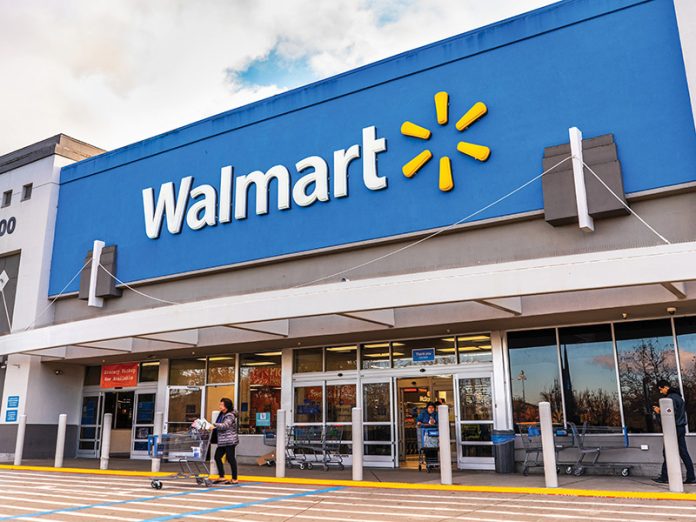By Kate Vitasek
Walmart has long been known for its supply chain prowess and muscle. But when it came to solving friction with carriers caused by “us versus them” data discrepancies in the freight payment process, it turned to collaboration and co-creation.Together, Walmart Canada, DLT Labs and Bison Freight designed and launched what is believed to be the world’s largest full-production blockchain solution to solve a problem plaguing most industries – freight payment discrepancies. The solution uses blockchain technology to revolutionise freight payment processes, reducing freight claim disputes 98.5 per cent.
Walmart delivers over 500,000 shipments annually to distribution centres and more than 400 stores across Canada, using both its own trucking fleet and 70 third-party carriers. The essential service of moving a massive quantity of goods (much of which is perishable) across borders, time zones, and different climates is an enormous operational challenge. For example, each load shipped requires tracking data points, such as stop locations, gallons of fuel, and temperature updates, that need to be independently calculated and incorporated into each invoice.
With over 200 data points that need to be factored into invoices, it is easy to see how vast discrepancies in data led to significant non-value-added reconciliation efforts due to the whopping 70 per cent of invoices that had discrepancies that needed to be reconciled. For Walmart, this meant substantial transaction costs and unhappy carriers feeling frustrated with an inconsistent payment process, and final payment sometimes extending weeks or even months beyond the invoice due date. For carriers, the problem was equally painful, with what seemed to be never-ending disputes revolving around “us versus them” versions of the truth that wreaked havoc on the carrier’s economics.
A root-cause analysis pointed to the use of multiple systems between Walmart and its carriers. Simply put, the systems could not talk to each other; reconciliation was manual, labour-intensive, riddled with inconsistencies, and time-consuming, all of which was exacerbated by the sheer volume of data.
Walmart’s freight payment reconciliation problem is not unique; most industries that rely on third-party carriers to ship their freight have similar issues. In fact, the problem is so big that it is very common for companies to hire third-party business process outsourcing service providers to sort through the invoices and manage their freight claims process.
An Open Mind for Change
Walmart didn’t start out thinking they would develop a blockchain solution to their freight payment problem. John Bayliss, EVP, Chief Transformation Officer, Walmart Canada explains how the initiative came about. “We had some very vocal carriers complaining about the lead times to settle accounts. One of Walmart’s tech leaders suggested automating the process with an external blockchain network.”
But there were sceptics, because blockchain technology had never been used before in a substantial, mission-critical function. Plus, Walmart was not an expert on blockchain.
But the idea of using blockchain technology was intriguing. Bayliss adds, “We knew the root causes were systems issues and not people problems. We also knew we were definitely not blockchain experts and if we were to go down that path, we would need a partner willing to co-create with us. So, I put the challenge out to the team to ask the question on what was the art of the possible.”
Walmart ultimately selected DLT Labs to help them both think through the blockchain solution and implement it. What started as a partnership with DLT soon extended to Bison Transport – one of Walmart Canada’s largest transportation providers. The blockchain network went live with Bison Transport in January 2020, with the remaining 69 carriers in Canada onboarding in March. A post-mortem with Walmart, DLT and Bison points to five lessons learned that can be universally applied to any company seeking to solve complex supply chain issues.
Lessons Learned
1. Have a Partnership Mentality, Not a Buyer/Supplier Mindset
Walmart has one of the world’s largest supply chains. Bison Transportation is one of the largest and most modern fleets in North America. And DLT Labs is a global leader in blockchain. All are best-in-class companies, but the lesson learned is to check your ego at the door and recognise that you don’t have all the answers for solving complex problems. Rather, if you get the right players in a room with the right mindset and let each person specialise, you have the best chance of finding the right solution.
For John Bayliss, setting a “what’s-in-it-for-we” tone from the start was essential. “Everyone involved in the initiative knew that Walmart was not a blockchain expert. If we were going to succeed, we’d need DLT Labs to be a peer and help us build something together as a partner – as a peer.”
2. Lay a Foundation of Transparency and Trust
A key enabler of putting a partnership mindset to work was the commitment to purposefully leading with transparency and creating a high-trust environment out of the gate. DLT and Bison credit Walmart with setting that tone and leading by example from the outset. Despite Walmart being the giant in the room by any standard, Walmart’s leadership insisted that the entire team was a unit in which anyone and everyone involved was treated equally.
Loudon Owen, CEO & Chair at DLT Labs, was impressed with how Walmart led by example when it came to transparency. “I think a key for us was the transparency and the openness which went all the way to the very top at Walmart, including very senior people. There were no sacred cows.”
With Walmart leading the way by example, the trio consciously set an expectation of extreme transparency with a common goal of getting to one version of the truth – technically and operationally. This transparency allowed the parties to look at inputs differently and enabled them to find ways to optimise across the entire supply chain, not just based on Walmart’s expectations.
3. Use a Dedicated Team
What struck Owen about the early interactions with Walmart was not just the big thinking, but rather Walmart’s approach.
The parties all agreed that if they were to have a chance of going from idea to implementation, they needed to put dedicated resources into the initiative to keep focus. Using a dedicated team meant having team members from each company sitting side by side. It also enabled the team to be agile, responsive and accountable; team members could be in a daily meeting in the morning and, immediately after lunch, go back to their respective organisations to troubleshoot or break down barriers as needed.
Owen was thankful that Walmart backed its words with consistent actions. “We were promised that we’d have access to whatever different groups we needed – and Walmart delivered on that promise. DLT Labs is a relatively small organisation compared to a giant like Walmart and it can be very challenging navigating an extraordinarily large and complex organisation. But we were shepherded all the way through with expedience from the beginning.”
4. Create Common Goals
Much has been written about the power of having a shared vision and common goals. This best practice was not lost on the leaders of Walmart, DLT and Bison. The joint team operated with three simple shared goals:
1. Resolve the time, cost and accuracy issues of carrier payments.
2. Drive efficiency, while accepting and building on the foundation of the existing process.
3. Increase visibility and trust in the freight invoice and payment process.
Having shared goals created the core tenets for the parties’ actions. There was never any doubt about the vision or the rules of the game. That made a huge difference. Every fundamental point raised was checked against the shared goals. If someone wanted to do something that didn’t support the goals, anyone on the team had the autonomy to throw the idea out on that basis. The process created trust and strong connections, with everyone on the same team, playing by the same set of rules.
Bayliss explains why having shared goals was important. “We kept coming back to these ‘core tenets’ because we knew if we could deliver on these common goals, we’d have a solution we’d all feel comfortable with. We all knew that – Bison, and DLT, and Walmart.”
5. Co-Create the Solution – Daily
With shared goals and a dedicated team in place, the question became just how the parties should collaborate. The decision? A true commitment to co-create – daily.
While the shared goals were important, Owen attributes equal importance to the companies’ co-creation approach. “Many companies ‘say’ collaboration – but they get the ‘how’ of collaboration wrong. They say, ‘Let’s have a meeting and then two weeks from now we’ll have another meeting.’ We met – and continued to meet – daily, until we had a workable solution that met our goal. What made the difference with this initiative was the commitment to the co-creation approach, which meant we had to put positive words into action and ensure that there was a living, daily process to unite everybody’s thoughts into a solution that would work for all parties. This process established integrity both between and within the teams right from the start.”
Bayliss agrees that co-creating was a game-changer. Collaboration is not just sitting in a room talking. It is getting out there and working on something – together. Side by side, without an ‘I am the customer and you are the supplier’ mindset.
True co-creation would mean the solution was not a Walmart solution, a Bison solution, or a DLT solution. Rather, the team would build a network solution; decisions would be made based on what was best for the network – not any individual organisation.
Results
By all accounts, the new freight payment solution using distributed ledger technology (blockchain) has been a tremendous success, leading to increased trust, efficiencies and savings. Before the DL Freight blockchain solution, over 70 per cent of invoices were disputed. The parties have reduced disputes by 98.5 per cent, and today fewer than 1 per cent of invoices have discrepancies. In addition, when there is a discrepancy, it is easily flagged and quickly resolved. Gone are the days of payments taking weeks or months; carriers are now getting paid on time.
One of the biggest benefits of the blockchain platform is the unprecedented level of trust it has created between Walmart and its carriers due to the end-to-end supply chain visibility among all parties. While the original goal was to eliminate disputes and wasted resources, the companies have learned that the real power of the blockchain solution is that it empowers Walmart and its supply chain partners to achieve insights and operational efficiencies that are transformative.
Conclusion – The Future of Blockchain Platforms
Blockchain technology is not new. But what is new is the fact that Walmart, DLT Labs and Bison Transport challenged the status quo and collaborated to create the world’s largest full-production blockchain solution. The success proves without a doubt that a large-scale blockchain solution is not only possible – but it generates a substantial ROI that improves bottom-line profits through efficiencies. The partnership developed a blockchain solution that should be a role model not only for those working with third-party transportation providers – but for all businesses.
About the Author
 Kate Vitasek is an international authority for her award-winning research and Vested® business model for highly collaborative relationships. She is a faculty member at the University of Tennessee and is the author of seven books and the Harvard Business Review article A New Approach to Contracts.
Kate Vitasek is an international authority for her award-winning research and Vested® business model for highly collaborative relationships. She is a faculty member at the University of Tennessee and is the author of seven books and the Harvard Business Review article A New Approach to Contracts.




































































